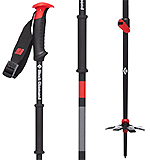 poles
poles
 poles
poles
People often assume that the use of fancy two or three-section poles is mandatory for backcountry use. They reason that climbing uphill may require a shorter length of pole than skiing, and that lengthening the pole for a long section of skating or shortening it to carry on your pack may make your life easier. True enough.
Why, on the other hand, can't you just tour with the alpine poles you already own? The short answer is that of course you can tour with non-adjustable poles, and in most cases will hardly notice the difference. In practice, most experienced backcountry skiers seldom adjust the length of their poles, preferring the faster method of simply gripping the pole by the shaft when they need a shorter length (ie. while traversing a steep slope). Very occasionally they will shorten the pole dramatically (for a steep boot-up section, to keep the pole from getting in their way) or lengthen it to "cross-country" dimensions to cross a frozen lake or skate a few miles down a logging road, but these are exceptions.


That said, most people who tour a lot eventually shell out the cash for adjustable poles of some sort. Adjustable poles come in either two or three-section designs, with the three-section models preferred for their shorter collapsed length by splitboarders, who commonly carry the poles on their pack for descending. Most touring models offer a reliable adjustment mechanism that doesn't slip, as well as an extended grip under the handle for gripping the pole lower down on the shaft.
There is also a choice between all-aluminum models, carbon fiber lowers with aluminum upper shafts, and all carbon-fiber poles. Carbon fiber shafts or lowers have reduced swing weight and heft, but may break in cases where an aluminum pole will simply bend. They may also be harder to repair by "splinting" in the field. (Many experienced skiers carry a short section of tubing that will fit inside their pole shafts plus a couple of hose clamps for emergency field repairs). With any pole, examine the lower shafts periodically for ski edge nicks that might compromise the strength of the shaft, and replace if necessary.
Whether or not to use the pole straps is a personal decision. There are those who always use them, those who take them off in high avalanche conditions or skiing trees, and those who never use them. Those in the latter category often remove them completely. Leki's Trigger S system is available on several of their touring models, and keeps the strap on the glove rather than attached to the pole handle. This may be the best of both worlds, letting you choose to not use the strap in certain situations.
Self-arrest handles, as represented by the Black Diamond "Whippet" below, are often used by steep skiers anticipating icy conditions. They can be an asset during the climbing phase as well as in an unexpected fall.

© 2022 Gregory C. Louie